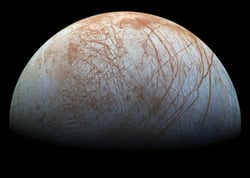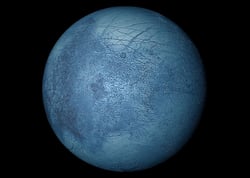Benchmark Teams with NASA to Develop Technology for Interplanetary Space
Developing technology for space is challenging. Developing technology for interplanetary space requires truly stratospheric skills. Here at Benchmark Lark Technology, we don’t shy away from a challenge, and nothing flexes our technical muscles more than partnering with the NASA-Jet Propulsion Laboratory (JPL) to design, manufacture, and test complex RF filters for interplanetary exploration.
Lark frequently designs custom RF filters for geostationary orbit satellites and low-earth orbit satellites for military and commercial communication applications. Our custom RF filters allow engineers flexibility in the rest of the system design and we pride ourselves on meeting each project’s unique and critical specifications.
Our work with NASA-JPL on the Europa Clipper spacecraft took our ability to customize filters to the next level. With a launch date of 2024, this interplanetary mission will send an un-manned spacecraft to conduct detailed reconnaissance of Jupiter’s moon, Europa, and investigate whether the icy moon could harbor conditions suitable for life. The Europa Clipper will travel more than 500 million miles before performing repeated close flybys of Europa, sending data back to Earth before succumbing to Jupiter’s extreme radiation.
Built to Survive
Lark’s work on the Europa Clipper began when long-time customer NASA-JPL provided us a limited spec sheet to build a prototype RF filter without details regarding the final application. It’s not uncommon for customers to require confidentiality around a filter project, and we can design and build a filter to specifications without additional details. After receiving our prototype filter, NASA-JPL engaged us for a more robust design partnership.
The data we received for the final filter design was surprising—about two pages of electrical drawings and roughly 30 pages of environmental and survival specs, including radiation hardening beyond a typical satellite application. Frankly, we’d never seen anything like it. That’s when we learned the filter would be used on NASA-JPL’s Europa Clipper spacecraft. Armed with this knowledge, we went to work on what was sure to be an exciting and challenging project.
Addressing the Challenge
As the development began, we knew we needed to solve two key challenges. First, the RF filter must survive constant vibration and extreme temperatures on the journey to Europa. Second, the filter required the highest-quality environmental protections to withstand Jupiter’s high radiation levels once it arrives.
To address the longevity challenge, we focused on a few critical processes: design engineering, manufacturing,  and test/inspection. Due to the violent nature of the launch and extremely long flight (even at high speeds, covering 500 million miles takes time!), the RF filter would be built and packaged using resilient materials with minimal failure points. The manufacturing process had to be tightly controlled to avoid any design variation, so we created a system with a higher-than-usual number of inspection points. Frequent in-process inspection is typically not cost-effective or required for a commercial application, but it can be an option for critical-reliability space applications. We needed to ensure everything was built to last in the harshest environment imaginable.
and test/inspection. Due to the violent nature of the launch and extremely long flight (even at high speeds, covering 500 million miles takes time!), the RF filter would be built and packaged using resilient materials with minimal failure points. The manufacturing process had to be tightly controlled to avoid any design variation, so we created a system with a higher-than-usual number of inspection points. Frequent in-process inspection is typically not cost-effective or required for a commercial application, but it can be an option for critical-reliability space applications. We needed to ensure everything was built to last in the harshest environment imaginable.
Once we’d developed multiple prototypes, we began putting the filters through numerous stress tests designed to simulate Jupiter’s moon’s launch and flight effects. One critical test involved a temperature chamber running the filters at full power under extreme heat (125º C). This test became the most strenuous part of the process. The filters went through roughly 1,000 hours in the chamber, with an inspection occurring every 100 hours.
Next, we put the filters through a temperature shock machine. During most of the Europa Clipper’s journey, the RF systems will not be fully operational to conserve power. Materials can become fragile in cold temperatures while the spacecraft is running at low power. When the spacecraft fires up again, the internal temperature rises quickly, and the immediate temperature change can damage parts. The test system simulated the shock of going from high temperatures at launch to frigid temperatures of space, followed by the higher temperatures of full operation. The temperature cycled multiple times during this portion of the test.
 Once we could prove the final filter would last through the launch and space flight’s environmental conditions, we began to look at radiation protection. The first step in this process was to select the right materials for the filter itself, so we worked with our suppliers to address this challenge. While they could guarantee some performance, they couldn’t give us precise data on how long the material would hold up in intensive radiation. After all, Jupiter’s radiation is equivalent to 100 million x-rays—even radiation hardening materials used as protection against solar radiation aren’t built for that!
Once we could prove the final filter would last through the launch and space flight’s environmental conditions, we began to look at radiation protection. The first step in this process was to select the right materials for the filter itself, so we worked with our suppliers to address this challenge. While they could guarantee some performance, they couldn’t give us precise data on how long the material would hold up in intensive radiation. After all, Jupiter’s radiation is equivalent to 100 million x-rays—even radiation hardening materials used as protection against solar radiation aren’t built for that!
We had to perform internal tests to validate whether the materials could meet the stringent specifications. As the RF filters are less vulnerable than the spacecraft’s active components, we could sufficiently harden them with the commercially-available materials. Since the radiation levels will be so high on this mission, NASA only expects the spacecraft to make a few trips around Jupiter before it succumbs to the emissions, and we expect the filters to hold up much longer than the spacecraft itself.
Mission Success
We delivered the completed, fully-tested filters to NASA so that the team can finish designing and building the spacecraft. As is often the case with complex systems, the RF filters we provide are only one of many essential parts. We highly recommend visiting NASA’s Europa Clipper website to learn more about this impressive feat of engineering. We are waiting patiently for the 2024 launch to see our work become a part of this historic quest to expand human knowledge.
NASA-JPL selected Benchmark Lark Technology for this project because of our long, established history of developing RF filters for the most unique and complex projects. There are very few providers of custom-designed RF components that can accommodate multiple performance and reliability requirements with consistent high-quality. Whether our customers are searching for signs of life in our solar system or building a satellite network that will expand broadband access in rural areas, we take pride in our ability to meet our customers’ needs in the space industry.
Want to learn more about our space capabilities? Check out bench.com/space. To learn more about Benchmark Lark Technology’s custom filter designs, visit bench.com/lark/rf-components-solutions.










